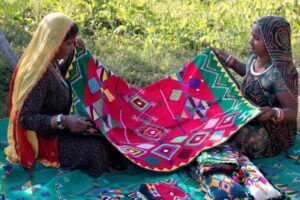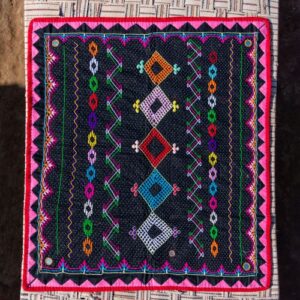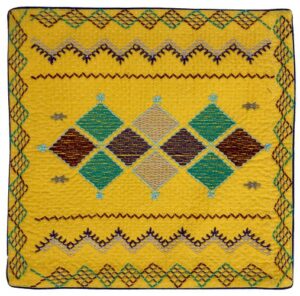Kalbelia Craft Revival Project aims to uplift community, offer sustainable living

Sutapa Chakraborty
As I stepped inside the hall of the Art Gallery, IIC Annexe, I immediately feel mesmerised and drawn towards a beautiful display of the most flamboyant quilts. A part of the Kalbelia Craft Revival Project, the quilts’ exhibition was organised by the Kota Heritage Society.
Woven by the women of the Kalbelia community, who are traditionally a group of snake charmers belonging to the Thar dessert of Rajasthan, the quilts charmed their way into the hearts of almost all the visitors to the show.
A closer look at the exhibits revealed a distinctive difference these had from the quilts of other communities. Their USP is a technique recognised as Doda Dora wherein after stitching layers of cloth together the surface is embroidered with varied patterns in which the needle passes angularly (called doda in vernacular language) through the stitched thread. The quilts appeared to spring to life with a wide variety of geometrical and colourful patterns that are created by doing embroidery over the stitches that act as reference points for needlework.
“These quilts are not ordinary by any means as they are a precious family heirloom given away as dowry and woven by aunts and mothers for their daughters and preserved as a family asset. If you rip off a Gudri (quilt) it speaks volumes about the tribe’s oral cultural history, textile tradition, indigenous learning methods, their nomadic movements and knowledge exchange with other communities,” said Dr Madan Meena, a practicing visual artist, curator and researcher working extensively with rural, nomadic and tribal communities.
“The motifs of the Kalbelia quilts are related to different scales of snakes, particularly those found in Rajasthan. Varied patterns of scales on the bodies of snakes are exactly replicated in their quilts,” he added.
In a talk on the subject on July 23, Dr Meena also explained that the Criminal Tribes Act of 1871, passed by the British Government, lists some 200 nomadic tribes as criminal communities. “And these tribes have been bearing the burden of this historical stigma ever since,” he said.
The Kalbelias were a community of craft groups and professional service providers working as snake charmers giving medicines to cure snake bites and possessed specific skills to help others. Now more than 70 per cent of them work as unskilled labors, 80 per cent of them don’t have citizenship entitlements and 75 per cent of them are illiterate.
Ironically, the Kalbelias’ song and dance forms have been recognised as a UNESCO Intangible Cultural Heritage of Humanity and their dancers perform on international stages, and receive about 25 per cent of the money. Once highly acclaimed, most of the retired and old dancers are today found begging on the streets of Jaipur for their sustenance.
“We invited Mewa Sapera here as she had accompanied Padmashree awardee Gulabo Sapera who would dance to Mewa’s songs. Now Mewa lives in a slum,” added Dr Meena.
“Our findings prompted us to start this Kalbelia Craft Revival Project to sustain these women. We advised them to take up this craft of quilt making and turn it into a means of livelihood. We offered to pay them Rs 300 daily to stop them from going back to begging or working as labour. Now they send their children to school,” he added.
Dr Meena said, “This is the first of its kind exhibition organised with an aim to establish the community and identify them for their unique craft as also for ensuring sustainability for the women.”





